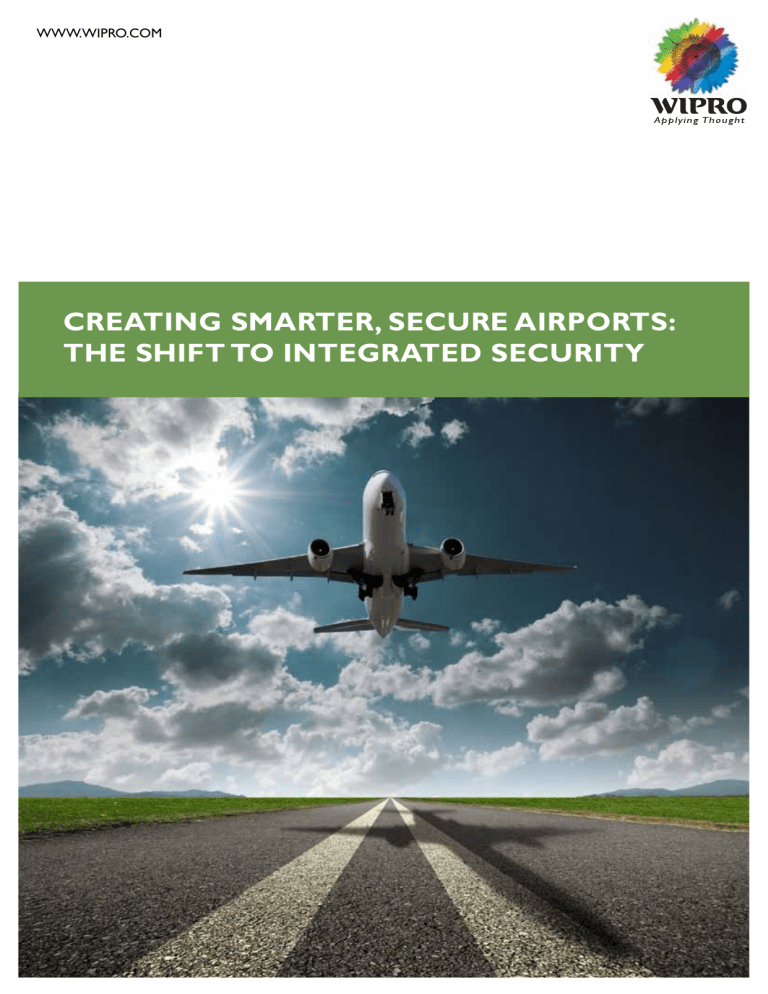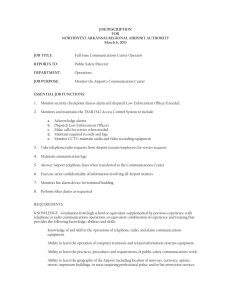
www.wipro.com
Creating Smarter, Secure Airports:
The Shift to Integrated Security
Table of Contents
Abstract
3
Introduction
3
Airport Security Challenges
4
The Need for an Integrated Airport Infrastructure
5
Key Elements of an Integrated Airport Security System
6
Concluding Thoughts
8
About the Author
9
About SIMS
9
Global Infrastructure Service
9
About Wipro IT Services
9
Abstract
While most airports have advanced security measures that entail multiple screening layers, body scanners and explosion
detection tools, the actual physical security of the airport has been relegated to the back seat. With constantly evolving
regulations and ever-growing incidents of sophisticated security attacks and escalating overheads, airports require
advance planning along with the necessary physical infrastructure to drive actionable intelligence. This whitepaper from
Wipro addresses the key security challenges that the modern airport faces today along with the need for an integrated
IP based security infrastructure. It also walks through the key elements of an connected security system that will enable
airports meet the increasing call for safe and efficient airport security.
Introduction
For instance, the Christmas Day bombing attempt of 2009
Airport security is a huge challenge with billions of
the Department of Homeland Security to make
passengers and baggage traversing through hundreds of
investments to the tune of hundreds of million dollars
airports and thousands of flights on a daily basis. According
in explosives detection systems, passenger screening
to the 2011 World Airport Traffic Report by ACI (Airport
technologies, and air cargo security for airports across the
Council
passenger
United States. In fact according to Global Industry Analysts,
numbers increased by 5.3% in 2011 to 5.44 billion and global
Inc., the worldwide airport security equipment market is
passenger traffic is expected to top 12 billion by 2031.
expected to reach USD 288.7 billion by 2015. However, these
International),
and the air cargo bombing attempt of 2010 have prompted
worldwide
airport
critical
investments are largely skewed towards internal screening
The booming air travel industry and stringent regulatory
measures while the actual physical security of the airport
requirements necessitates regular overhauls of airport
has been relegated to the back seat. The key question now
runways and other infrastructure to keep up with current
and future demand. Moreover, the continuously growing
is - are airports doing enough to safeguard the actual
physical airport infrastructure?
sophistication of threats are forcing airport to become
highly vigilant and are dictating the need for smarter
The following sections discuss the various challenges
security solutions. These factors are driving investments
associated with airport security and the need for an
to the tune of billions of dollars towards the development
integrated physical security infrastructure for a truly effective
of identification and screening technologies such as radio
security solution.
frequency identification (RFID) technology, biometrics and
prototype screening devices among others.
3
Airport Security Challenges
protected by a basic layer of a perimeter intrusion detection system
along with obsolete barriers such as analogue cameras, high walls
Airports pose a labyrinth of unique security challenges due to the
and barbed wire fences. Moreover, considering the fact that there are
sheer scale, volume and cost of infrastructure and people involved.
huge and complex networks of disparate technologies dotting the
Further, with restricted and sensitive areas within and around airport
airport landscape, airports typically face a huge challenge of inter-
terminals, it is imperative for the authorities to constantly monitor and
operability of these legacy systems. In many cases, these systems are
record all movements. However, there are significant challenges that
supplied by different vendors and function in silos, thereby providing
span a gamut of factors such as:
a fragmented security picture, leading to slow decision making and
inefficiencies – both of which can have serious consequences with
Protecting airport
infrastructure
Utilizing the right
detection technologies
and equipment for
passenger, baggage and
cargo screening
millions of lives at stake.
These challenges coupled with the pressure from new airline
alliances, low cost operators, and the increasing incidences of airport
privatization and acquisition are resulting in a far more competitive
environment. Operational efficiency has never been as important as it is
Ensuring secure
passenger
authentication and
identification
Ensuring operational
security with in-flight
security as well as safe
and efficient air traffic
management
today with the focus on driving a more advantageous cost base without
compromising growth, quality, safety and security across a wide range
of issues and potential threats. This requires increased automation and
integration of airport systems to enable a clear, consistent and timely
view of the entire airport operation.
More than 1,300 perimeter security incursions have been
As discussed in the previous section, airports have largely focused
reported at US airports since 9/11, yet 87% of the nation’s
their efforts on screening and detecting breaches inside the airport
airports have not been through a perimeter security
main premises. The harsh fact is that most airport grounds are
assessment.
- US Rep. Bill Keating (MA-10)/GAO
4
The Need for an Integrated Airport Infrastructure
Let us consider a scenario where an alert related to a breach at a remote area away from the airport hub is triggered. The efforts of the airport
authorities to track down this breach are typically stonewalled due to several reasons which make the process of finding the intruder much harder.
Some of the key reasons are -
Traditional Analog CCTV System
Traditional analog CCTV system
used for monitoring located at a
seperate on-site location
No way of accessing live images
and monitoring remotely
Poor and degraded image quality
due to far distance of camera
location & bad weather
Radio
Communications
No visibility or update from
deployed security forces
other than intermittent radio
communications
Basic Perimeter
Protection
Authorities unable to pinpoint the exact location and
movements of the intruder due
to lack of sensors in the area
Security breach
Figure 1: Assessing Security at the Airport Premise
Assume there has been a significant lapse of time between the breach alert
infrastructure investments in recent times, this airport boasts a
and the ensuing response. What if the team cannot find the intruder quickly?
swanky premise with cutting-edge facilities, high-speed metro link
What if the intruder is a terrorist? Shouldn’t there be a better way of triggering off
connectivity and is expected to handle 100 million passengers by
the alarm earlier and enabling real-time tracking along with a coordinated effort
2030. Considering the sheer size and scope of this airport, it would
with multiple teams for an effective security incident resolution?
almost be impossible to envisage the disastrous consequences and
potential losses that a perimeter security breach could entail.
As the above example emphasizes - the traditional physical security
protection tools are no longer enough to protect an airport even
With attacks becoming more and more sophisticated, there is a strong
if its internal screening processes are highly advanced. A major
need for an intelligent and integrated airport security infrastructure.
airport in South Asia for instance spent billions of dollars on a new,
Airport security solutions are typically a multilayered surveillance
modern terminal and to upgrade operations. As one of the largest
approach with a combination of ‘smart’ fences and sensors in conjunction
5
with IP CCTV cameras for intelligent surveillance, analytics and access
control along with rapid response teams. However, each of these
solutions if purchased separately can be a huge administrative burden
on the airport’s IT staff. These disparate systems will require its own
set of dedicated services, maintenance and training. By integrating
these separate security systems under a single console, airport
authorities can realize significant advantages of an considerably
5 Key Benefits of an Integrated
Security System
1. Reduced incident vulnerability and
increased incidence responsiveness
more powerful security solution at far lower costs.
2. Holistic approach to control by multiple
uses of component devices
At the core of this system integration is a cohesive and unified control
3. Ease of installation of multiple systems
on a single interface
center that seamlessly assimilates information from multiple systems
to provide a single point of view of all operations. With an integrated
control center solution, airport authorities benefit from situational
awareness and can quickly assess and proactively respond to an
4. Flexibility and ability to easily integrate
new security components
5. Operational and maintenance costs
intrusion before it escalates to a serious security incident.
Key Elements of an Integrated Airport Security System
A truly integrated airport security system typically encompasses three main elements – Monitoring,Tracking & Detection and Mobility solutions.These
aspects are linked together by the fourth element - a Command and Control Center to mitigate risk across the airport environment by providing
actionable intelligence and enabling speedy security incident resolution.
Tracking &
Detection Systems
•
Video Surveillance
•
Video Analytics
•
Access control
Mobility Solutions
•
Taut wires
•
Electro-optical bars
•
Buried cables
•
Radar system with
cameras
•
Fire and Safety
Monitoring Solutions
•
Vehicle Mounted Camera
•
Vehicle PC
•
Guards with PDAs
•
GPS base vehicle tracking solution
Integrated Airport
Security System
Figure 2: Integrated Airport Security System
6
Monitoring Solutions
observation of sensitive locations or observation of potential trouble
Video Surveillance and Analytics
spots. This high resolution radar can accurately detect personnel and
There has been a growing shift to IP based CCTV cameras that
vehicles up to 1400 meters in virtually any weather or lighting condition
provide significant advantages such as scalability, remote monitoring
to provide 24/7 security.
over internet and easy sorting of digital video files. These IP-based
solutions also support intelligent video analytics that augment the
Fire and Safety
video surveillance systems with real-time detection and alerts for
Fire and safety tools are a key feature of airport security and offer a
defined events.
range of detectors from optical to multi-sensor detectors.
Access Control
Mobility Solutions
An airport environment requires a comprehensive solution ensuring
Vehicle Mounted Camera
security across multiple levels that can be seamlessly integrated with
The vehicle is equipped with basic CCTV equipment, communication
third party applications like fire, video, BMS and other such applications.
equipment, and video display systems along with seating capacity for
These include usages of smart cards, biometric readers, visitor
operators. The Mobile Video Van is maintained in a complete state of
management systems and so on.
readiness and is capable of capturing and streaming real-time video
feeds of an incident.
Tracking & Detection Systems
Taut Wires
Vehicle PC
Taut wires are embedded with electromechanical sensors and can be
This is installed in a vehicle to automatically provides alerts to patrolling
erected as stand-alone fencing, attached to conventional chain-link
teams in real time and allows the command and control room to know
fencing, or mounted on existing walls, gates, roofing, etc. These sensor
its exact location using secure communication lines and GPS.
switches are sensitive and tamper proof and a major advantage of this
system is that it does not require power supply.
Guards with PDAs
PDAs provide live videos and alerts from the control room to the field
Electro-optical bars
force using a built-in Wi-Fi communication card and Wi-Fi cloud.
These are steel barriers with an integrated alarm system and serve as
an intrusion detection grid in common passage ways like water pipes,
GPS based Vehicle Tracking Solution
windows, canals, etc.This grid is fully functional in a wide range of weather
This solution enables airports to track the location of its assets –
conditions and even functions smoothly when submerged under water
moving or stationery - in real time and respond to any requirement
for years. Any attempt to cut or remove a part of the grid, or the grid
with precision.
itself, is immediately detected by the opto-mechanical mechanism.
Command and Control Center
Buried cables
This integrated solution enables an airport to increase situational
These cables consist of sensors (transmitter and receiver) and are
awareness throughout its infrastructure by creating a unified and
buried inside the perimeter. An invisible EM detection field forms
interactive intelligence picture, drawing data from all sensors,
around the cable, which detects the presence of intruders within the
showing the location of the patrols and adding other relevant
field with an accuracy of + 1 meter.
information such as video from different sources. This combined
picture is constantly updated and can be sent by the Control Center
Radar system with cameras
to all patrols, thereby serving as a uniform basis for operational
This system enables seamless monitoring and round-the-clock
planning and allocation of tasks.
7
Concluding Thoughts
Airports worldwide are viewed as potential targets for terrorism and other forms of crime due to the sheer scale of infrastructure and the number of
people concentrated in a particular location. It is a typical misconception in an average person’s mind that the threat lies inside the terminal and the
periphery where security officials must be ready for any eventuality. However, the security of facilities, infrastructure and strategic assets at airports
and in the immediate vicinity is an integral part of a total airport security model and equally critical in ensuring the safety of millions of travelers.
Amid ever changing regulations and with new threats continuing to emerge, airports require advance planning along with the necessary infrastructure
to drive actionable intelligence. In the light of these developments, there has been a marked shift towards IP based integrated and networked
platforms. These platforms help airports reduce overall IT requirements and the need for training. It also empowers authorities with a single control
console that allows them to perform their tasks far efficiently and thus foresee and protect their facilities from potential threats.
8
About the Author
Chockalingam Chidambaram
Chockalingam currently heads the IBMS and PSS practice of System Integration Services at GlS – Wipro Infotech. He
has a comprehensive Sales and Marketing experience for over 2 decades across varied sectors in India, SAARC and
Middle East.. He has been a known face in the Surveillance industry with working experience in Industry Majors like
Bosch & Honeywell. He has been associated in quite a few landmark projects. As a part of his current role, he carries
the charter of establishing and developing the IBMS & PSS practice for India, Middle East and Africa for Wipro Infotech.
About SIMS
Wipro’s System Integration and Maintenance Services (SIMS) is a part of Global Infrastructure Services of Wipro.We provide end to end technology services
including consulting, system integration and project management with a 3D model of Design, Deploy and Dedicate 24X7 Support.With our vendor neutral
approach and best of breed technologies,We ensure all IT worries of the clients are left to us while they concentrate on their business goals.
Our certified processes and over 15 years of service experience are reflected in the success we have achieved in executing projects. Strategic alliances
with leading technology players further enable us to deliver cost-effective integration services that are steady, scalable, smart, and innovative and result
oriented for your business. Being a pure-play system Integrator, we deliver the best of breed solutions to customers with our vendor agnostic approach.
Global Infrastructure Services
Wipro’s Global Infrastructure Services (GIS) is a pioneer in the Infrastructure Management services space with revenues of 2Bn USD. This division
contributes to over 30% of IT revenues of Wipro Ltd, with a headcount of over 26,000+ technical specialists. Our strong domain capabilities and
specialized offerings help businesses across the globe transform their vision to results. Backed by our strong network of iGCCs (Integrated Global
Command Centers) and 10 owned datacenters spread across US, Europe and India, GIS is enabled to provide cost variabalization, accelerated growthand
continuous innovation for global businesses. Few of our industry specific service offerings include Wireless Place, Shoptalk™, Bank-in-a-Box while our
traditional offerings include data center management, cloud, managed network, managed security, end user computing and business advisory services
About Wipro IT Services
Wipro IT Services a part of Wipro Limited (NYSE:WIT) is a leading Information Technology, Consulting and Outsourcing company, that delivers
solutions to enable its clients do business better. Wipro delivers winning business outcomes through its deep industry experience and a 360 degree
view of “Business through Technology” – helping clients create successful and adaptive businesses.A company recognized globally for its comprehensive
portfolio of services, a practitioner’s approach to delivering innovation and an organization wide commitment to sustainability, Wipro IT business has
135,000 employees and clients across 54 countries.
For more information, please visit or contact www.wipro.com us at info@wipro.com
Disclaimer:The material in this document is provided “as is” without warranty of any kind, either express or implied, including but not limited to, the implied warranties of merchantability,fitness for a particular
purpose, title and non-infringement.The material are subject to change without notice and do not represent a commitment on the part of Wipro. In no event shall Wipro be held liable for technical or editorial
errors or omissions contained in the material, including without limitation, for any direct, indirect, incidental, special, exemplary or consequential damages whatsoever resulting from the use of any information
contained in the material.The materials may contain trademarks, services marks and logos that are the property of third parties.All other product or service names are the property of their respective owners.
9
DO BUSINESS BETTER
W W W. W I P R O . C O M
N Y S E : W I T | OVER 130, 000 E M P L OY E E S 5 4 C O U N T R I E S | C O N S U L T I N G | S Y S T E M I N T E G R AT I O N | O U T S O U R C I N G
WIPRO INFOTECH, DODDAKENNELLI, SARJAPUR ROAD, BANGALORE - 560 035, INDIA TEL : +91 (80) 2844 0011, FAX : +91 (80) 2844 0256, email : reachus@wipro.com
©Copyright 2013. Wipro Limited. All rights reserved. No part of this document may be reproduced, stored in a retrieval system, transmitted in any form or by any means, electronic,
mechanical, photocopying, recording, or otherwise, without express written permission from Wipro Limited. Specifications subject to change without notice. All other trademarks mentioned
herein are the property of their respective owners. Specifications subject to change without notice.









